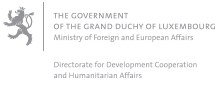- Home
- Preface
- I. Luxembourg’s Official Development Assistance in 2012
- DAC peer review
- On the path to 2015
- II. Cooperation with partner countries
- III. Regional cooperation and cooperation with other countries
- IV. Multilateral cooperation
- V. Cooperation with non-governmental organisations
- VI. Humanitarian aid
- VII. Programme support
- VIII. Awareness-raising and development education
- IX. Microfinance
- X. Evaluation
- XI. Progress report on the Inter-ministerial Committee for Development Cooperation
- Appendices
I. Luxembourg’s Official Development Assistance in 2012

Burkina Faso - Training in steel construction
Progress in official development assistance
The 25th session of the UN General Assembly adopted resolution 2626 on 24 October 1970. The resolution confirmed that ‘‘developing countries must, and do, bear the main responsibility for financing their development’’, but emphasised that “however great their own efforts, these will not be sufficient to enable them to achieve the desired development goals as expeditiously as they must unless they are assisted through increased financial resources and more favourable economic commercial policies on the part of developed countries”. This ‘‘official development assistance’’ to be made available by every economically advanced nation was fixed at ‘‘a minimum net amount of 0.7 per cent of its gross national product at market prices’’.
Luxembourg’s ODA initially underwent slow but constant growth: as a proportion of gross national product (GNP) it grew from 0.10 % in 1981 to 0.32 % in 1991 (1.262 billion Luxembourg francs).
On 31 July 1991 the government set itself the goal of achieving 0.35 % of GNP by 1995. This target was reached in 1996 with disbursements amounting to 2.554 billion Luxembourg francs (0.43 % of GNP).
In the meantime at the Earth Summit held in Rio de Janeiro in June 1992, Prime Minister Jacques Santer officially announced Luxembourg’s intention of aiming higher and ‘‘reaching the 0.7 % of GNP by the year 2000’’.
This objective was confirmed by the new incoming government in 1994. In view of the continued growth of official development assistance – from 0.34 % of GNP in 1994 to 0.62 % in 1998 – it was decided during the formation of the government in 1999 to adopt the 0.7% target for the year 2000 and to subsequently increase this assistance ‘‘with a view to approaching 1 % by the end of the legislature’’.
The first objective was reached as foreseen in 2000: with sum totalling more than 5.382 billion Luxembourg francs (133.433 million euros), Luxembourg reached the threshold of 0.7 % of gross national income (GNI) for the very first time and thus became one of the leading five donors in the world in percentage terms. The subsequent years saw the confirmation of this commitment, with ODA increasing from 0.77 % in 2001 to 0.97 % in 2008.
In 2009, for the first time, Luxembourg’s official assistance exceeded the 1 % traget with disbursements of 297.817 million euros (1.11 % of GNI).

